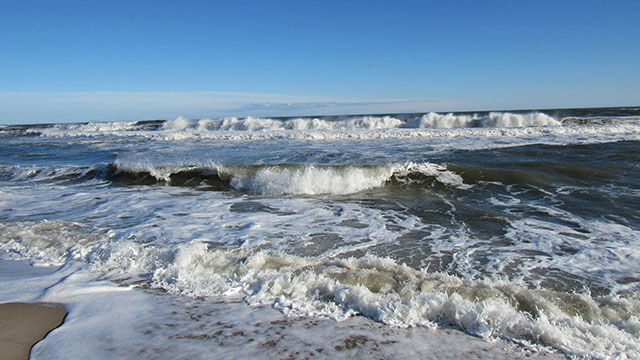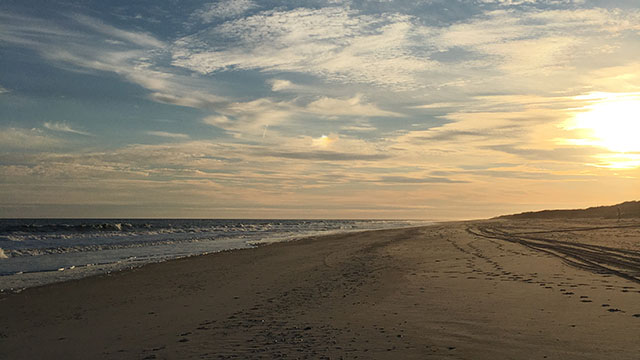Are you ready for the summer? Want to surf, swim, fish, sunbathe, or just relax and catch a spectacular sunset? Well be careful where you put your toes and towels on the beaches because the heat is on, and not just the global warming kind. As President of the Southampton Association for Beach Access (SABA), John Kosciusko, simply states, “This is why we live here, with 26 plus miles of beaches, let’s open it up even more.”
However, following three lawsuits in which the Southampton Town Trustees lost one, won one on a reversal, and lost the third, and now that the Court of Appeals has denied their petition to be heard, the result is the Southampton Town Trustees have been stripped of their authority within the villages to regulate activities regarding the public access easement along the ocean beaches, as well as to regulate structures, seawalls and any beach hardening on the easement. That means that villages now have jurisdiction within their boundaries. Southampton Town Trustee Ed Warner, feeling “very unappreciated for what we do” clarifies, “Historically, the Town Trustees have defended the beaches and beach access for the freeholders, taxpayers, residents and commonality of the town of Southampton of 26 miles of ocean beach easement.”
Warner continued, “We can still regulate outside of the villages, and it should be stressed that the Trustees own the underwater lands within the town and that area on the beach which falls under an easement and which is within a village. The question in the Village of Southampton especially relates to beach driving and how that is regulated, along with structures.”
 |
|
Nothing beats a Hamptons sunset. (Photo: Nicole Barylski) |
During the mid-1640’s, the original freeholders of the townships were given deeds, one of which pertained to the bay bottoms, estuaries and ocean front water along our shores. Realizing the importance to the lifestyle of the citizenry, access to the ocean front water outlets was given to the populace for their enjoyment and managed by Town Trustees, and private homeowners rights extended only to the mean high water mark.
However, with time comes different socio-economic changes, and these rights, which have been upheld for hundreds of years, have been challenged repeatedly by those who might not wish to view the masses outside their ocean front properties, or want to control certain public access to beaches.
At least two not-for-profit organizations based in the Hamptons have followed these proceedings carefully, and with a definitive mission.
SABA, founded approximately nine years ago, declares they are a “group of concerned local families and residents who have joined together with the intent of enlisting support from all of the people who use our beaches for family recreation, fishing and relaxing with friends.” The original focus of the group was to support the Town Trustees who had been vested with the authority to protect the citizens of the Town of Southampton and access to the ocean beaches.
 |
|
Beach erosion and environmental concerns warrant serious interest by us all. (Photo: Nicole Barylski) |
“We as a group have been pushing the Town Trustees to open up additional beach access locations, particularly west of the Shinnecock Canal, as well as east, but who knows how this recent Court of Appeals denial will affect everyone who accesses the beaches,” noted Kosciusko. “Wouldn’t it be terrible to see private fences on either side of property down to the water?”
It’s an issue that raises a huge concern for beachgoers. “Town Boards and Town Trustees are separate, and these lawsuits have undermined and challenged the authority of the Trustees to protect these rights, and presently that authority has been removed, now with no authority in the villages it is feared that the Town Trustees will continue to become so compromised that the Town Boards in the villages may now maintain that citizens do not have the rights to enjoy many of the ocean beaches,” Kosciusko explained. “We will continue to support the Town Trustees, and ignorance by the public of this matter will only be further detrimental as it could impact everyone’s access to certain beaches.”
President of the Citizens for Access Rights (CfAR), Tim Taylor, explained “CfAR was founded in response to the Napeague beach lawsuit.” He noted that both organizations have similar objectives. “CfAR and SABA’s missions do not differ all that much,” said Taylor. “The goal of both are to protect public access to the beaches of the Towns of East Hampton and Southampton in all forms as they have been used for generations.”
 |
|
Spending time at the beach is something East Enders might take for granted. (Photo: Nicole Barylski) |
CfAR founded in 2010, and based in East Hampton, has made it its mission to “support any governing body that is willing to oppose the privatization of our beaches, and to protect ALL forms of public access to our beaches and preserve the rights and traditions enjoyed by residents since colonial times.” Further, CfAR wants “to ensure that full access and recreational opportunities are open to the greatest number of people, not just the privileged few, and to promote and encourage proper stewardship of our beaches and coastal waters.”
“Simple common sense seems not to have played any role here,” added Warner. “Town Trustees have always regulated the easement, and just one item that has long been proposed is that regulations be in place that mandate that if any property needs to be moved back, then it should not be replaced. Many homeowners however have a pull in local government, and the villages are not enforcing this condition.”
Taylor relayed, “In regards to the recent situation with the Southampton Town Trustees, the biggest difference here is that in Southampton the Trustees do not own the beaches, however they do manage them.” Further east, it’s a combination of ownership. “In East Hampton the Trustees own some of the beaches and manage them. The recent ruling takes away the Trustees management of the incorporated villages of Southampton, but not the town beaches,” Taylor said. “This means that there will be different rules on the village beaches versus the town beaches. In East Hampton most of the Village and Town beaches are owned and managed by the Trustees.” The decision may not directly impact beaches in East Hampton, but CfAR still considers it a setback. “The ruling doesn’t affect the East Hampton Town Trustees at all, however, any loss of public access or of governing access to the beaches is a loss. We support all of SABA’s efforts to maintain public access in Southampton,” he added. “The threat to ownership and access to public beaches is real and is evident throughout several areas on the East End. We must remain vigilant for all beach access issues to protect this right for generations to come.”
 |
|
Realizing the importance to the lifestyle of the citizenry, access to the ocean front water outlets was given to the populace for their enjoyment. (Photo: Nicole Barylski) |
Restriction of or denial of access to beaches through privatization is not just an ‘us versus them’ argument, or who has access to where. Beach erosion and environmental concerns warrant serious interest by us all. Not convinced? Well in addition to what is affecting the shores in both Southampton and East Hampton, think about the historic Montauk Lighthouse, commissioned by George Washington and opened in 1796, and built approximately 300 feet from the cliff – today, it stands about 75 feet from the edge! In Southampton, the natural flow of beach sand could be interrupted and properties to the west have suffered and could continue to suffer damage due to erosion.
What’s next? Warner replied, “At this point, our recourse is to reach out to both Senator Kenneth LaValle and Assemblyman Fred Thiele and hope that they can get state legislation passed that will clarify exactly what Town Trustees can regulate in the villages. We don’t want gray – we want black or white.”
Let us all hope that in the future there will still be beaches left for all private homeowners, residents and visitors to enjoy.






